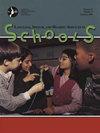Development and Validation of Kindergarten Dynamic Assessments of Early Reading and Language.
IF 2.9
3区 医学
Q1 AUDIOLOGY & SPEECH-LANGUAGE PATHOLOGY
Language Speech and Hearing Services in Schools
Pub Date : 2025-07-10
DOI:10.1044/2025_lshss-24-00078
引用次数: 0
Abstract
PURPOSE The purpose of this study was to develop and evaluate the initial reliability and validity evidence of the dynamic assessment (DA) of early reading and language as a second-stage screener in kindergarten, the first year of formal schooling. The DA comprises three subtests that capture students' ability to learn letter sounds and blending and infer word meaning from context by providing a series of graduated prompts, from the least to most helpful sequence, depending on students' responsiveness and documenting students' learning process. METHOD Concurrent data on DA and static screeners at the beginning of kindergarten (N = 164, Mage = 5.60, 4-6 years old) were analyzed using item response theory, confirmatory factor analyses, and receiver operating characteristics curve models. RESULTS Item response theory analyses identified the optimal number of prompts for each DA subtest, and they were rescaled accordingly. Confirmatory factor analyses of the rescaled DA indicated three distinct subscales comprising letter sound, blending, and vocabulary learning with high reliability coefficients and construct validity evidence demonstrating theoretically expected correlations with the static screener. Finally, when DA was added to the static screener for identifying students with disabilities, DA improved specificity by reducing the number of false positives. CONCLUSIONS Our preliminary investigation demonstrated the DA's appropriate reliability and validity as a supplemental screener. Future directions include evaluating the DA's predictive validity evidence and classification accuracy with a large student sample and norm-referenced standardized measures, addressing the limitation of the current study using school-identified disability classification as a criterion measure. SUPPLEMENTAL MATERIAL https://doi.org/10.23641/asha.29425259.幼儿园早期阅读与语言动态评价的发展与验证。
目的本研究的目的是开发和评估早期阅读和语言动态评估(DA)的初步信度和效度证据作为第二阶段筛选在幼儿园,第一年的正规教育。DA包括三个子测试,通过提供一系列从最没有帮助的顺序到最有帮助的提示,来捕捉学生学习字母发音和混合以及从上下文中推断单词含义的能力,这取决于学生的反应能力和记录学生的学习过程。方法采用项目反应理论、验证性因子分析和受训者操作特征曲线模型,对4 ~ 6岁的幼儿(N = 164, Mage = 5.60)和静态筛选者在入园时的并发数据进行分析。结果题目反应理论分析确定了每个DA子测试的最佳提示数,并相应地调整了提示数。经验证性因子分析发现,三个不同的子量表包括字母发音、混合和词汇学习具有较高的信度系数,并且构造效度证据表明理论预期与静态筛选器相关。最后,当将DA添加到静态筛选器中以识别残疾学生时,DA通过减少假阳性的数量来提高特异性。结论初步调查表明,DA作为一种辅助筛选方法具有良好的信度和效度。未来的发展方向包括通过大量学生样本和规范参考的标准化措施来评估DA的预测效度证据和分类准确性,解决当前研究使用学校识别残疾分类作为标准措施的局限性。补充MATERIALhttps: / / doi.org/10.23641/asha.29425259。
本文章由计算机程序翻译,如有差异,请以英文原文为准。
求助全文
约1分钟内获得全文
求助全文
来源期刊

Language Speech and Hearing Services in Schools
Social Sciences-Linguistics and Language
CiteScore
4.40
自引率
12.50%
发文量
165
期刊介绍:
Mission: LSHSS publishes peer-reviewed research and other scholarly articles pertaining to the practice of audiology and speech-language pathology in the schools, focusing on children and adolescents. The journal is an international outlet for clinical research and is designed to promote development and analysis of approaches concerning the delivery of services to the school-aged population. LSHSS seeks to advance evidence-based practice by disseminating the results of new studies as well as providing a forum for critical reviews and meta-analyses of previously published work.
Scope: The broad field of audiology and speech-language pathology as practiced in schools, including aural rehabilitation; augmentative and alternative communication; childhood apraxia of speech; classroom acoustics; cognitive impairment; craniofacial disorders; fluency disorders; hearing-assistive technology; language disorders; literacy disorders including reading, writing, and spelling; motor speech disorders; speech sound disorders; swallowing, dysphagia, and feeding disorders; voice disorders.
 求助内容:
求助内容: 应助结果提醒方式:
应助结果提醒方式:


